Psoriasis: a dermatologist’s guide for patients
This comprehensive dermatologist guide helps patients learn everything they need to know about psoriasis, including its causes, symptoms, types, treatment options, and how to get a prescription.
Table of Content:
Causes | Symptoms | Types | Stages | Triggers and risk factors | Getting a diagnosis | Medications | Topical medications | Oral medications | Biologic medications | OTC creams and supplements | How to prevent flares? | Complications | FAQ
Our commitment to producing high-quality content:
The information presented in this article is based on scientific research and the professional advice of our Content Medical Reviewers, who are experts in the field of Dermatology. How we write our content →
What is psoriasis?
Psoriasis is a chronic inflammatory condition that may affect up to 4.8% of the population. It is characterized by the formation of scaly plaques on the skin, most often on the knees, elbows, scalp, and lower back, but it can affect any body area. Psoriasis is caused by uncontrolled inflammation in the skin,which leads to redness and an accelerated growth rate of skin cells which accumulate to form scaly plaques.
Psoriasis mostly affects the skin, but may be associated with other health conditions, most commonly arthritis. It has also been linked to increased rates of heart disease, and possibly many other problems including diabetes, anxiety and depression, and inflammatory bowel disease. Rarely, it can even impact your eyes , especially in women1 2 3.
Although psoriasis manifestations are usually chronic, patients with psoriasis often go through cycles of symptoms, experiencing periods of flare-ups that can last several weeks before diminishing4.
What causes psoriasis?
The exact cause of psoriasis is unknown, but it’s believed to be related to dysregulated immunity in the skin T-cells and other white blood cells, called neutrophils. Genetics and environmental factors likely play an important role, but how to modify them in order to improve psoriasis is not entirely clear.
Psoriasis symptoms
Psoriasis symptoms can vary depending on the type of psoriasis and its severity, but they often share the same characteristics.
- Red, raised, inflamed plaques of skin that are often covered with silvery scales and can be itchy or painful.
- Dry skin that may crack and bleed in severe cases.
- In areas where skin touches skin like the groin, armpits, under the breasts, or between the butt cheeks, often no scale is present and the skin appears and feels raw and irritated.
- Affected areas may feel itchy or burning especially during flare-ups, and sometimes the skin feels sore or burned.
- Psoriasis can affect fingernails and toenails, causing them to become thick, pitted, and discolored.
- In some cases, the inflammation seen in the skin can also affect the joints, known as psoriatic arthritis, which results in swollen, stiff, and painful joints.
- Symptoms can flare up for a few weeks or months before subsiding or going into remission. Flare-ups can be triggered by various factors, including stress, skin injuries, infections, and certain medications5.
Types of psoriasis
Plaque psoriasis
Plaque psoriasis is characterized by red, purple or brown plaques, with overlying silvery scale that manifest as large, oval to circular skin lesions across the scalp, trunk, and extensor surfaces of the body which can be itchy and sore. In people with Caucasian skin, these plaques usually show up as raised, reddish lesions topped with a silvery white layer of dead skin cells, known as scales. On darker skin tones, the plaques tend to be darker, taking on a purple, grayish, or deeper brown hue6.
These plaques can develop anywhere on the body but are most commonly found on the scalp, knees, elbows, and midsection. They typically form in a symmetrical pattern, affecting identical areas on both the right and left sides of the body.
The scalp, behind the ears, and around the belly button are important areas to check in suspected cases of psoriasis, as changes there can indicate the disease is developing. Psoriasis affecting the scalp and face can show up in different ways, including psoriasis around the hairline, sebopsoriasis (a combination of seborrheic dermatitis and psoriasis), and psoriasis on the face7. Redness and fissuring in the crevice at the top between the butt cheeks, called the intergluteal cleft, is another very common area to get psoriasis that may go unnoticed or be misdiagnosed.
Guttate psoriasis
Guttate psoriasis is often triggered by strep infections and is more frequent in children and teens and it responds well to topical treatments. Those affected develop numerous small, red spots on the skin, resembling drops, usually measuring between 2 to 6 millimeters. For some, it resolves after the strep infection and skin lesions are treated, but for many it is an unmasking of a prior predisposition to psoriasis, and becomes chronic.
These spots can appear in areas of the skin that have been injured or irritated (like cuts, sunburn, or other skin infections). This response happens because the skin starts to grow too quickly in the healing process, leading to psoriasis lesions. Although guttate psoriasis is a classic example of this phenomenon, other skin conditions can also show this response, including lichen planus, flat warts, vitiligo, and lupus, among others8.
Pustular psoriasis
Pustular psoriasis is a rare skin condition that’s part of the psoriasis family. It shows up as white or yellow pus-filled blisters(pustules) on red skin and comes in different types and patterns. Unlike the more common type of psoriasis, which usually isn’t painful to touch, these affected areas can be tender. Because they are filled with a type of white blood cell they contain pus, but they don’t contain bacteria or viruses so it is not an infection. Pustular psoriasis can manifest in a variety of locations, including widespread body involvement or localized to the palms, soles, or fingers and toes9.
Inverse psoriasis
Inverse psoriasis (also referred to as intertriginous psoriasis) tends to be more common in overweight people and it affects skin folds like the groin, armpits, between the buttocks, and under the breasts. It also happens in babies and young children, with some experiencing a psoriasis that can be confused with an ordinary diaper rash. The skin patches seen in inverse psoriasis are smooth, clearly outlined, red, and not very scaly. The redness is more intense in inverse psoriasis because of inflammation and irritation from rubbing, sweat, and moisture. Diagnosing inverse psoriasis can be difficult because its symptoms are similar to other skin conditions like yeast infections, intertrigo, diaper rash, ringworm, and dermatitis caused by allergies or irritants10.
Erythrodermic psoriasis
Erythrodermic psoriasis is a very severe and uncommon type of psoriasis, affecting less than 2% of people with psoriasis. It causes widespread redness and inflammation over 75% to 90% of the body. The exact cause is unclear, but it might be linked to a specific immune system reaction. Because it can be very serious, recognizing it as a manifestation of psoriasis is important. Erythrodermic psoriasis involves widespread involvement of the skin, covering more than 80% of the body surface area. Discrete lesions are often not present but instead there are wide areas of bright red skin.. People with erythrodermic psoriasis might also experience body-wide symptoms such as fever, fast heart rate, tiredness, discomfort, chills, dehydration, swollen lymph nodes, joint and muscle pain, sleeplessness, sweating, changes in bowel habits, weight changes, skin sensitivity, and in rare cases, severe heart problems and weight loss. It usually occurs in patients with a known history of psoriasis, but can be the first manifestation of the skin disease. It requires immediate treatment due to potential complications11.
Psoriatic arthritis
Psoriatic arthritis is a type of arthritis that occurs in about 20% of people with skin psoriasis, and it is more strongly associated with severe psoriasis. Its onset is usually seen in patients in their 30s and 40s and occurs about equally in men and women. Psoriatic arthritis causes inflammation in the joints and shares symptoms with other types of arthritis like rheumatoid arthritis, though the diseases and treatments are distinctly different in many cases. The symptoms can vary widely and may change over time. The causes of psoriatic arthritis are not fully understood yet, but they include a mix of genetic traits and environmental influences that trigger inflammation in the skin, joints, and other parts of the body. About one-third to half of the people with psoriatic arthritis have a close family member who also has psoriatic arthritis or psoriasis. Flares may be triggered by environmental factors (like an infection or physical stress) that can ignite the inflammation leading to long-lasting disease. Research has suggested that, changes in the gut bacteria may also affect this process, but the exact nature of this and how to modify it to improve disease is still being explored12.
Psoriasis stages (severity)
Dr. Trowbridge says the severity of psoriasis is often assessed based on the extent of skin involvement, the impact on the patient’s quality of life, and the response to treatment. Here’s a breakdown of how severity can be described.
Mild psoriasis
- Coverage: Less than 3% of the body is covered in psoriasis plaques.
- Impact: The condition has a minimal impact on quality of life.
- Management: Often treated with topical treatments.
Moderate psoriasis
- Coverage: Between 3% to 10% of the body is affected.
- Impact: The condition has a moderate impact on the patient’s quality of life, possibly affecting daily activities or emotional well-being.
- Management: Might require a combination of treatments, including topical therapies, phototherapy, and sometimes systemic medications.
Severe psoriasis
- Coverage: More than 10% of the body is affected.
- Impact: The condition significantly impacts the patient’s quality of life, potentially hindering their ability to perform certain tasks, and is associated with greater psychological distress.
- Management: Often requires systemic treatments, biologic drugs, or a combination of different treatments.
Furthermore, psoriasis can be considered severe anytime it results in significant emotional or quality of life consequences as it often does if it involves the hands, feet, scalp, face, and genitals; or, if it does not respond to an exhausted attempt at topical therapies.
Facial psoriasis
Facial psoriasis is a particularly challenging and distressing form of psoriasis, as it affects a highly visible and sensitive area of the body. This condition can manifest on the eyebrows, the skin between the nose and upper lip, the upper forehead, and the hairline. People with facial psoriasis often experience red, scaly patches that can be itchy and painful. Due to the delicate skin on the face, treatment requires a careful and gentle approach, often involving low-strength topical steroids, vitamin D analogues, and moisturizers designed for sensitive skin. Managing facial psoriasis also includes avoiding triggers such as stress and certain skincare products that can aggravate the condition. Your online dermatologist may recommend a tailored treatment plan that minimizes symptoms while being mindful of the skin’s sensitivity, aiming to improve the individual’s quality of life and self-esteem.
Psoriasis triggers and risk factors
Genetic predisposition
A family history of psoriasis increases the risk of developing the condition.
Ethnicity
Although there may be a higher predisposition in white populations compared to Black, Asian, and Hispanic populations, it is common in all races and ethnicities.
Stress
Many patients endorse emotional stress as trigger for the development or worsening of psoriasis symptoms.
Infections
Certain infections, especially streptococcal throat infections, can trigger psoriasis in some people.
Smoking
Smoking can increase the risk and severity of psoriasis symptoms and may even influence the type of psoriasis.
Alcohol consumption
Heavy drinking can exacerbate psoriasis and may interfere with the effectiveness of treatment.
Obesity
Excess weight increases the risk of psoriasis and may also affect its severity, especially in cases of inverse psoriasis which occurs in skin folds.
Medications
Certain medications, including beta-blockers, lithium, and antimalarial drugs, can trigger or worsen psoriasis in some individuals.
Hormonal changes
In the case of women with psoriasis, flare ups may occur during hormonal changes, such as puberty, menopause, or pregnancy.
Climate
Cold, dry weather can worsen symptoms, whereas warm, sunny climates may improve them.
Skin injury
It is quite common that an individual may experience new skin lesions on skin previously unaffected before the skin injury took place. This type of reaction is associated with psoriasis and other skin conditions, such as vitiligo, and lichen planus, among others. For example, after a scratch, cut, bruise, or even sunburn, you may develop psoriasis on the site of injury.
What medications can you get?
Dr. Trowbridge says there are currently many prescription medications available for the treatment of psoriasis, which include topical, oral and biologic medications (injections).
Topical psoriasis medication
Topical creams and ointments for psoriasis are a cornerstone in managing psoriasis. These treatments are applied directly to the skin and include corticosteroids, vitamin D analogues, retinoids, and calcineurin inhibitors. They work by reducing inflammation, slowing down skin cell growth, and flattening lesions, providing relief from itching and scaling. Ideal for mild to moderate cases, topical therapies are often the first line of treatment, with their effectiveness enhanced when combined with other treatments like phototherapy or systemic medications for more severe cases.
Oral psoriasis medication
Oral psoriasis medications play a critical role in the treatment of moderate to severe psoriasis and cases where topical treatments are insufficient. These systemic treatments are taken by mouth and work throughout the body. They include methotrexate, which reduces inflammation and suppresses the rapid skin cell production; cyclosporine, an immunosuppressant that decreases the immune system’s activity; and acitretin, a retinoid that slows skin cell growth. Newer oral treatments, such as apremilast, work by targeting specific molecules within immune cells to reduce inflammation and plaque formation. Oral medications can offer significant improvements, but they also carry the potential for more pronounced side effects and require careful monitoring by healthcare professionals.
Biologic medications for psoriasis
Biologic psoriasis medications represent a revolutionary approach in treating moderate to severe psoriasis and psoriatic arthritis, particularly for patients who have not responded well to traditional systemic treatments. These advanced therapies are administered via injection and work by targeting specific parts of the immune system that drive inflammation, a key factor in psoriasis. While biologics can offer significant relief and clear or nearly clear skin for many patients, they also require ongoing monitoring for potential side effects, including an increased risk of infection.
OTC creams and supplements
Over-the-counter (OTC) psoriasis creams and supplements offer accessible relief for many individuals dealing with mild psoriasis symptoms. These creams and ointments primarily focus on moisturizing the skin, reducing inflammation, and alleviating itching.
Can psoriasis cause any complications?
Dr. Trowbridge says that people living with psoriasis can experience various complications, both physical and psychological, that may affect their overall quality of life. Some of the potential complications include the following.
Physical complications
- Psoriatic arthritis: About 20-30% of people with psoriasis have or develop psoriatic arthritis, which causes joint pain, stiffness, and swelling.
- Other autoimmune diseases: Increased risk of developing conditions such as Crohn’s disease, celiac disease, and sclerosis.
- Cardiovascular problems: Psoriasis, especially if severe, is linked to a higher risk of heart attack, stroke, and other cardiovascular issues due to inflammation.
- Metabolic syndrome: A higher incidence of obesity, high blood pressure, high cholesterol, and type 2 diabetes, all of which are risk factors for heart disease.
- Eye conditions: Such as conjunctivitis, uveitis, and blepharitis.
- Infections: People with psoriasis may be more prone to infections due to their compromised skin barrier and possible effects of systemic treatments on the immune system.
- Liver disease: Including a higher risk of developing nonalcoholic fatty liver disease.
- Kidney disease: More common in those with moderate to severe psoriasis.
Psychological complications
- Mental health issues: Increased risk of depression, anxiety, and low self-esteem due to the chronic and visible nature of the disease.
- Social challenges: The appearance of skin lesions can affect social interactions, intimacy, and may lead to social isolation or relationship difficulties.
- Substance abuse: Some individuals may turn to alcohol or tobacco, which can worsen psoriasis symptoms.
Lifestyle-related complications
- Impact on quality of life: Chronic pain, itching, and scaling can interfere with daily activities, sleep, and overall well-being.
- Treatment Side Effects: Some medications for psoriasis and psoriatic arthritis can have side effects ranging from mild to severe, affecting other aspects of health.
That is why it is important for individuals with psoriasis to have regular follow-ups with their healthcare providers to manage the condition and monitor for these potential complications. Interdisciplinary care, including dermatologists, rheumatologists, and mental health professionals, can help manage the broad impacts of psoriasis.
Frequently asked questions about psoriasis
Will the online dermatologist be able to write me a psoriasis prescription?
Yes, the online dermatologist will give you a prescription that is adequate for the severity of your condition, your preference and your medical history.
Is psoriasis contagious?
Dr. Trowbridge says that psoriasis is not contagious. You cannot catch it from or transmit it to another person.
Can psoriasis be cured?
There is currently no cure for psoriasis, but many treatments are so effective that while taking the medications patients often have no signs of psoriasis.
At what age does psoriasis usually start?
Dr. Trowbridge says that psoriasis can manifest at any point in life but typically emerges during two peak periods: between the ages of 15 to 20 and 55 to 60.
Developing psoriasis at a younger age often correlates with a more intense form of the disease. Additionally, a familial predisposition is common, with about 36% of individuals with psoriasis reporting a family history of the condition.
What other conditions can look like psoriasis?
Several skin conditions can mimic the appearance of psoriasis, leading to potential misdiagnosis.
- Eczema (Atopic Dermatitis): Eczema causes itchy, inflamed patches of skin, often more commonly found in skin folds. Unlike psoriasis, the skin may be more weepy or crusty.
- Seborrheic Dermatitis: This condition often affects the scalp, face, and chest, presenting with red, scaly patches. It’s sometimes confused with scalp psoriasis.
- Lichen Planus: Lichen planus produces purple, itchy, flat-topped bumps. It can affect the skin and mouth but usually lacks the silvery scales seen in psoriasis.
- Pityriasis Rosea: This causes a large, scaly, pink patch of skin, followed by additional patches. Its oval shape and the body distribution pattern can sometimes resemble guttate psoriasis.
- Ringworm (Tinea corporis, cruris, pedis, manuum): A fungal infection that leads to ring-shaped, circular, or ill-defined itchy plaques on the skin. It might be mistaken for psoriasis but typically has a more distinct edge and central clearing.
- Cutaneous Lupus Erythematosus: This autoimmune condition presents with scaly plaques and inflammation on the skin, often with sensitivity to sunlight. It’s discoid variant can mimic psoriasis.
- Contact Dermatitis: Caused by skin contact with an irritant or allergen, leading to red, itchy rashes. Unlike psoriasis, removing the irritant usually resolves the rash.
- Tinea Versicolor: A fungal infection characterized by small, discolored patches on the skin, which can sometimes look like the lighter plaques of psoriasis.
- Scabies: Caused by mites, scabies present with intense itching and often small scaly skin lesions or a more widespread eczema-like rash, which might be confused with small psoriasis plaques.
- Syphilis: In its secondary stage, syphilis may cause a rash that resembles psoriasis, affecting the palms and soles.
How is psoriasis treated?
Dr. Trowbridge says that treatment options include topical treatments (creams and ointments), phototherapy (light therapy), and systemic medications (oral or injected drugs that affect the whole body), including biologics.
Can diet affect psoriasis?
While there’s no definitive diet for managing psoriasis, some people find that certain foods can trigger flare-ups. Eating a balanced and healthy diet can help control inflammation and manage symptoms.
Can stress cause a psoriasis flare-up?
Dr. Trowbridge says that stress is a known trigger for psoriasis flare-ups. Managing stress through relaxation techniques, exercise, or therapy can help reduce the frequency and severity of flare-ups.
Is psoriasis related to other health conditions?
Yes, psoriasis is associated with psoriatic arthritis, cardiovascular disease. In some cases it may also be associated with type 2 diabetes, and obesity, but there is inconclusive clinical evidence.
How can I support a loved one with psoriasis?
Support can include being understanding about their condition, encouraging them to follow treatment plans, and helping them avoid known triggers. Offering emotional support and understanding the psychological impact of psoriasis is also important.
Lee este artículo en Español : Psoriasis sintomas y tratamiento
Article References:
https://www.ncbi.nlm.nih.gov/books/NBK448194/
https://jamanetwork.com/journals/jamadermatology/fullarticle/2518351#
https://www.ncbi.nlm.nih.gov/books/NBK482498/
https://www.ncbi.nlm.nih.gov/pmc/articles/PMC7489316/
https://www.niams.nih.gov/health-topics/psoriasis#
https://www.ncbi.nlm.nih.gov/books/NBK537002/
https://jddonline.com/articles/treatment-of-inverseintertriginous-psoriasis-updated-guidelines-from-the-medical-board-of-the-nation-S1545961617P0760X
https://www.ncbi.nlm.nih.gov/pmc/articles/PMC5572467/


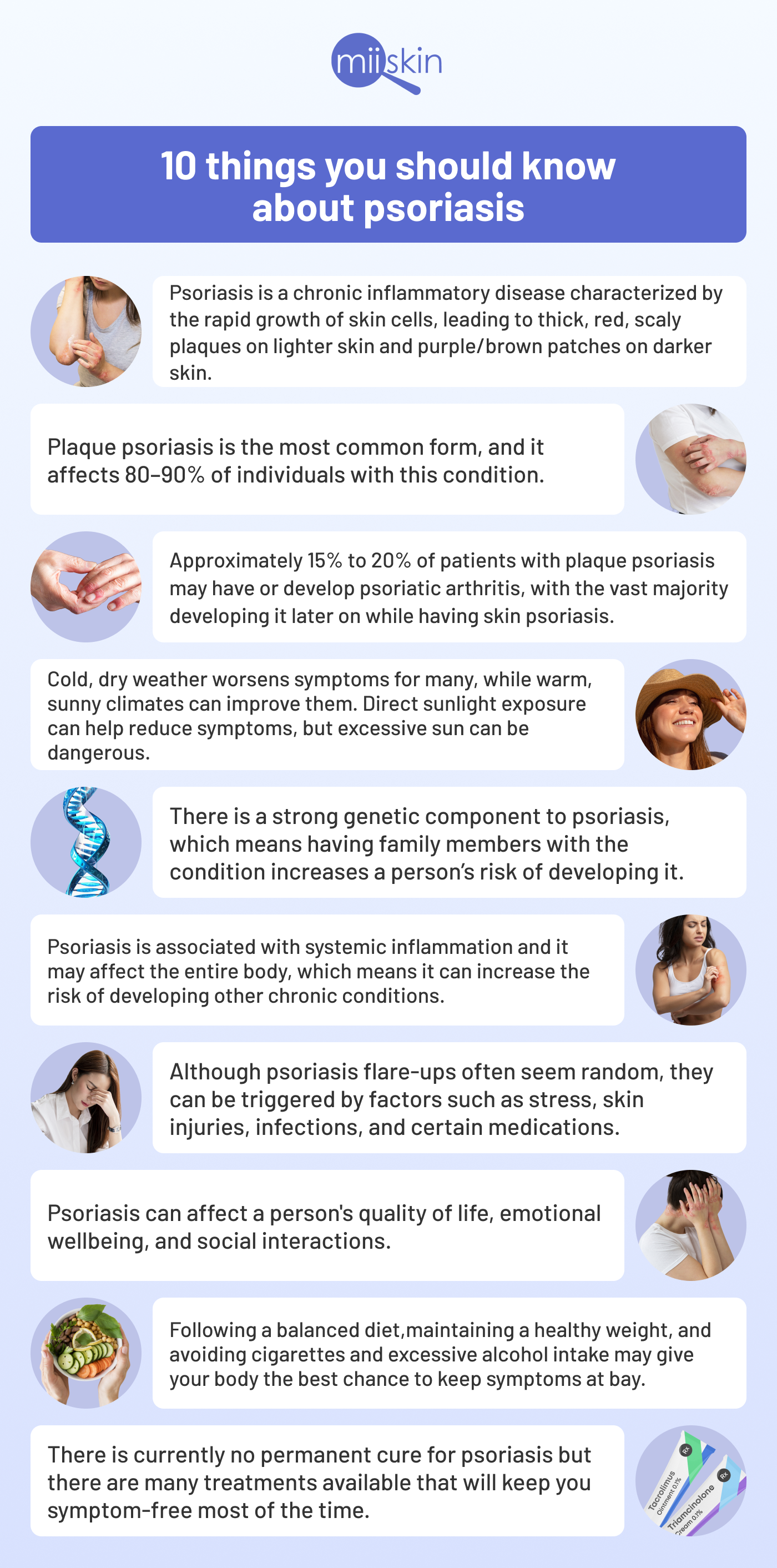
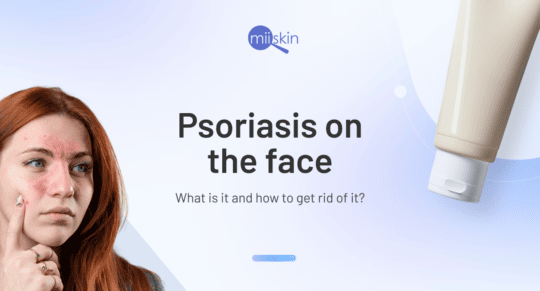
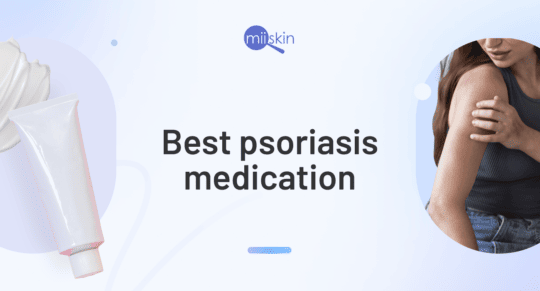
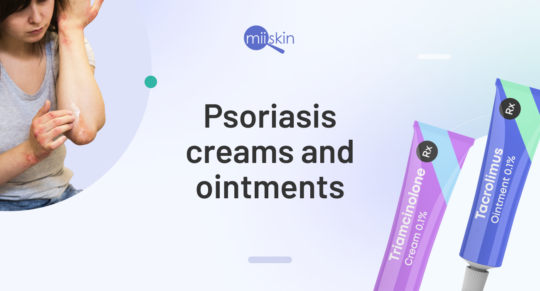
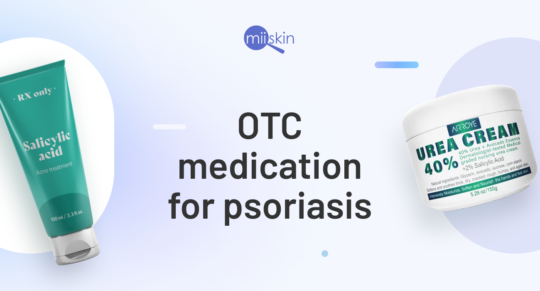
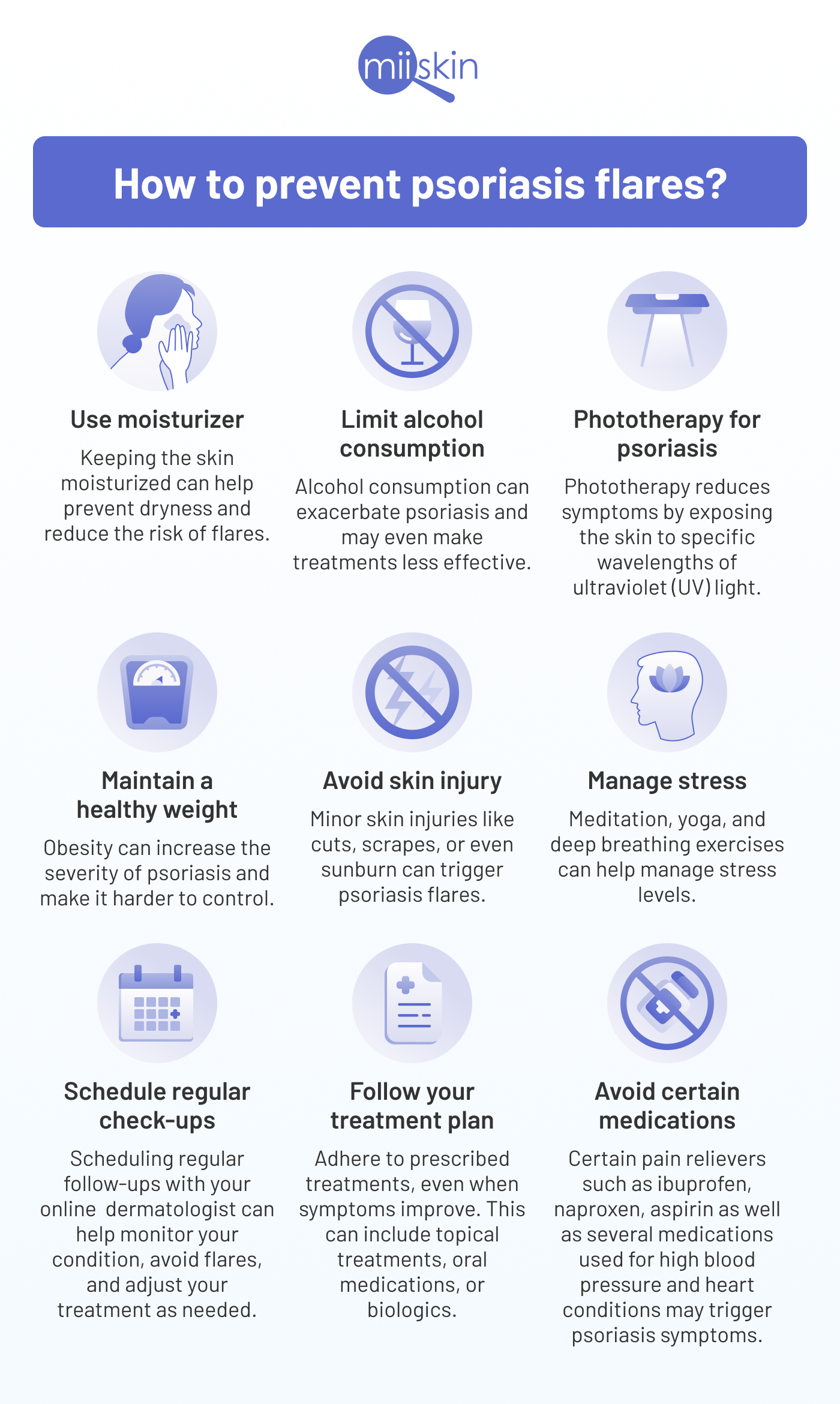
 Interested in getting medication for psoriasis?
Interested in getting medication for psoriasis?